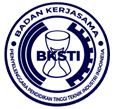Analysis of Work Accident Risk in Production Section Using Hazard Analysis and Operability Study (HAZOP) and Analytical Hierarchy Process (AHP) (Case Study: PT XYZ)
Abstract
Keywords
Full Text:
PDFReferences
Cantika, N.A., Fathimahhayati, L. D., & Pawitra, T. A. (2022). K3 Risk Assessment in Fuel Flow to Storage Tanks Using HAZOP and FTA Methods. INTECH Journal of Industrial Engineering, Serang Raya University, 8(1), 67–74. https://doi.org/10.30656/intech.v8i1.4640
Casban, C. (2018). Analysis of the Causes of Work Accidents in the Washing Corner Process in the Cleaning Division using the Fishbone Diagram and SCAT Methods. Jurnal Integrasi Sistem Industri, 5(2), 111-121.
https://doi.org/10.24853/jisi.5.2.111-121
Jumanto, J., & Nasution, A. P. (2017). Pengaruh Keselamatan dan Kesehatan Kerja (K3), Kedisiplinan dan Pengawasan Kerja Terhadap Produktivitas Karyawan Bagian Seksi Cutting Crimping di PT. Sumitomo Wiring Systems Batam Indonesia. Jurnal Bening, 4(2), 1–21. https://doi.org/10.33373/bening.v4i2.726
Line, M., Di, B., Harjohn, P. T., Mondina, R. R., Roslinda, E., & Hardiansyah, G. (2019). Efisiensi Tenaga Kerja Produksi Kayu Lapis Menggunakan Metode Line Balancing di PT. Harjohn Timber LTD. Jurnal Hutan Lestari, 7(2), 773–785. https://doi.org/10.26418/jhl.v7i2.34071
Misra, I., Hakim, S., & Pramana, A. (2020). Risk Management of Islamic Economic Business Approach. K-Media Publisher, Yogyakarta.
Ningsih, S. O. D., & Hati, S. W. (2019). Analisis Resiko Keselamatan Dan Kesehatan Kerja (K3) dengan Menggunakan Metodehazard And Operability Study (HAZOP) pada Bagian Hydrotest Manualdi PT. Cladtek BI Metal Manufacturing. Journal of Business Administration, 3(1), 29-39. e-ISSN:2548-9909
Nugroho, S. (2021). Analysis and Accident Control Efforts in the Can Production Section of PT XY Sidoarjo Using the HAZOP Approach. Doctoral dissertation: Universitas 17 Agustus 1945).
Ponda, H., & Fatma, N. F. (2019). Hazard Identification, Assessment and Control of Occupational Safety and Health (K3) Risks in the Foundry Department of PT. SICAMINDO. Journal of Heuristic Industrial Engineering, 16(2), 62–74. https://doi.org/10.30996/he.v16i2.2968
Putri, S. R., & Widjajati, E. P. (2021). Occupational Safety Risk Analysis in the Cutting Machine Maintenance Department of PT XYZ Using the Hazard and Operability Study (HAZOP) Method. Journal of Industrial Management and Technology (Juminten), 2(2), 156–167. https://doi.org/10.33005/juminten.v2i2.246
Ramadhani, N., & Rini, W. N . (2021). Study of Hazard Identification, Risk Analysis and Hazard Control at PT X in 2021. Journal of Public Health, 8(2), 168–179. ISSN 2442-4986. https://doi.org/10.31602/ann.v8i2.5105
Sasongko, A., Astuti, IF, & Maharani, S. (2017). New Employee Selection Using AHP (Analytic Hierarchy Process) Method. Informatics Mulawarman: Scientific Journal of Computer Science, 12(2), 88. https://doi.org/10.30872/jim.v12i2.650
Satriani, N. N., Cholissodin, I., & Fauzi, M. A. (2018). Decision Support System for Determining BBP-PPA Scholarship Recipients Using the AHP-PROMETHEE I Method Case Study: FILKOM Universitas Brawijaya Sentiment Analysis View project Deep Intelligence Smart Government View project. Journal of Information Technology and Computer Science Development, 2(7), 2780-2788. http://j-ptiik.ub.ac.id
Setiawan, E., Tambunan, W., Kartika, D., Kuncoro, R. (2019). Analisis Risiko Keselamatan dan Kesehatan Kerja Menggunakan Metode Hazard Analysis. JIME (Journal of Industrial and Manufacture Engineering), 3(2), 95 - 103. https://doi.org/10.31289/jime.v3i2.2959
Supriadi, A., Trisatya, D. R., & Sulastiningsih, I. M. (2020). Properties of Plywood Made from Five Types of Wood from Riau. Indonesian Journal of Agricultural Sciences, 25(4), 657–663. https://doi.org/10.18343/jipi.25.4.657
Tyas, A. A. W. P (2011). Pentingnya Keselamatan dan Kesehatan Kerja dalam Meningkatkan Produktivitas Kerja Karyawan. Forum Ilmiah, 8(3), 217-223. https://ejurnal.esaunggul.ac.id/index.php/Formil/article/view/778
Yuliandi, C. D., & Ahman, E. (2019). Application of Work Safety and Health (K3) in the Work Environment of Artificial Insemination Center (BIB) Lembang Application of Work Safety and Health (K3) in the Work Environment of Artificial Insemination (Bib) Lembang. Managerial: Journal of Management and Information Systems, 18(2), 98–109. http://ejournal.upi.edu/index.php/manajerial/
DOI: http://dx.doi.org/10.22441/ijiem.v6i2.30043
Refbacks
- There are currently no refbacks.

This work is licensed under a Creative Commons Attribution-NonCommercial 4.0 International License.
IJIEM - Indonesian Journal of Industrial Engineering & Management
Program Pascasarjana Magister Teknik Industri Universitas Mercu Buana
Kampus Menteng - Gedung Tedja Buana, Floor 4th
Jl. Menteng Raya No. 29 Jakarta Pusat- Indonesia
Tlp.: +62 21 31935454 Fax: +62 21 31934474
http://publikasi.mercubuana.ac.id/index.php/ijiem
Email: [email protected]

This work is licensed under a Creative Commons Attribution-NonCommercial 4.0 International License.
The journal is indexed by:





1.png)
.png)
.png)
.png)







